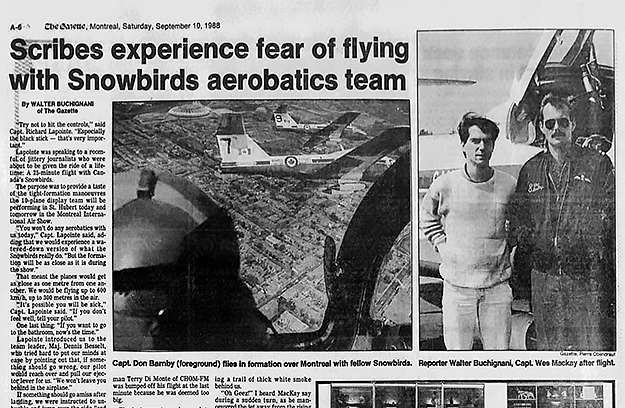Date: September 10, 1988
Location: Montreal, Canada
By: Walter Buchignani
Newspaper: The Gazette
Page: A6
“Try not to hit the controls,” said Capt. Richard Lapointe. “Especially the black stick – that’s very important.”
Lapointe was speaking to a roomful of jittery journalists who were about to be given the ride of a lifetime: A 25-minute slight with Canada’s Snowbirds.
The purpose was to provide a taste of the tight-formation manoeuvers the 10-plane display team will be performing in St. Hubert today and tomorrow in the Montreal International Air Show.
“You won’t do any aerobatics with us today,” Capt. Lapointe said, adding that we would experience a watered-down version of what the Snowbirds really do. “But the formation will be as close as it is during the show.”
That meant the planes would get as close as one metre from one another. We would be flying up to 600 km/h, up to 300 metres in the air.
“It’s possible you will be sick,” Capt. Lapointe said. “If you don’t feel well, tell your pilot.”
One last thing: “If you want to go to the bathroom, now’s the time.”
Lapointe introduced us to the team leader, Maj. Dennis Besselt, who tried hard to put our minds at ease by pointing out that, if something should go wrong, our pilot would reach over and pull our ejector lever for us. “We won’t leave you behind in the airplane.”
If something should go amiss after landing, we were instructed to unbuckle and jump over the side “and keep running until someone catches up with you.”
My pilot was Capt. Wes MacKay, 26, of Camrose, Alta. MacKay has been piloting for 10 years and has racked up more than 3,500 flying hours. This is his second and final year with the Snowbirds.
Members of the team, chosen among volunteers across the country, undergo a rigorous six-month training program before they undertake public shows.
Among world’s best
These pilots are considered among the best in the world. Still, my mind played back slow-motion TV footage of the recent West German air-show disaster that killed 52 people and injured about 500.
Organizers of this weekend’s air show say the pilots will perform higher and farther from crowds than the Italian pilots who crashed.
And they say the manoeuver that led to the accident doesn’t meet the safety standards set for Canadian shows.
“Will we really be flying three feet away from the other planes?” I asked my pilot.
“You’ll see,” MacKay replied with a devilish grin.
The red and white CT-114 Tutor jets were lined up side by side on the runway, each with its canopy raised.
Cpl. Denis Fontaine of Greenfield Park helped strap on my parachute and showed me how to work the oxygen mask on my helmet.
Fontaine helped me into the cockpit on the right side of jet No. 8 and strapped me into the seat.
There wasn’t much room to move even if I wanted to. Radio morning man Terry Di Monte of CHOM-FM was bumped off his flight at the last minute because he was deemed too big.
The instrument panel was cluttered with gauges and buttons of various shapes, sizes and colors. So was the floor console. So was the console to the left of my head. Tutor jets are used to train pilots and come with duplicate sets of controls.
The black stick I was warned about came up from between my feet. I took particular note, however, of the white paper bag to my right.
Capt. MacKay, clad in a red uniform, settled into his seat.
“How you doing?”
“Great,” I said. “This is exciting.”
“We haven’t done anything yet,” he said, and flicked a few buttons to check that everything was in working order. Soon, static crackled through my earphones and I could hear team leader Maj. Besselt run off several commands.
“Here we go,” MacKay said and pressed a small, red button labelled ACTUATE. The canopy came down and then forward, locking into place. MacKay flicked switches. The engines were running. The jet was moving.
From our position at the back of the squadron, I watched the first three jets lift off in perfect synchronicity, as if they were somehow attached. Then the tree just ahead of us did just the same.
Then it was our turn and, after a short climb, MacKay manoeuvred the jet next to the others.
For the next 25 minutes, there were many short climbs and sudden drops and sharp curves as MacKay handled the control lever.
The Snowbirds swooped around Olympic Stadium and over downtown skyscrapers before heading toward Dorval airport and back, leaving a trail of thick white smoke behind us.
“Oh Geez!” I heard MacKay say during a sudden turn, as he manoeuvred the jet away from the rising wing of the closest plane.
“What’s wrong?” I jumped.
“Nothing,” he replied through my earphones. “I didn’t anticipate it. I was a little behind on that one.”
“That was close,” I said.
“That was nothing,” MacKay said with a smile.
You can catch the air show, dubbed Expo Air, at 9 this morning.
Aside from the Snowbirds aerobatic displays, there will be other shows and exhibits today and tomorrow, until 6 p.m. Tickets are $6. Admission for children under 12 is free today and $3 tomorrow.
Parking limited
Wings of Hope, the organizers of the event, will donate all proceeds for development aid in Peru.
Parking at St. Hubert airport is limited, so organizers are advising people to take the Metro to Longueuil, where free shuttle service to the show will be provided.
CAPTION:
#1: Capt. Don Barnby (foreground) flies in formation over Montreal with fellow Snowbirds.
#2: Reporter Walter Buchignani, Capt. Wes MacKay after flight.
